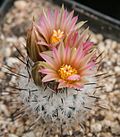
In 1984, the International Organization for Succulent Plant Study set up a working party, now called the International Cactaceae Systematics Group, to produce a consensus classification of the cactus family, down to the level of genus. Their classification has been used as the basis for systems published since the mid-1990s. Treatments in the 21st century have generally divided the family into around 125–130 genera and 1,400–1,500 species, which are then arranged in a number of tribes and subfamilies. However, subsequent molecular phylogenetic studies have shown that a very high proportion of the higher taxa are not monophyletic, i.e. they do not contain all of the descendants of a common ancestor. As of August 2023, the internal classification of the family Cactaceae remained uncertain and subject to change. A classification incorporating many of the insights from the molecular studies was produced by Nyffeler and Eggli in 2010.

Cochemiea is a genus of cactus. It has previously been synonymized with Mammillaria, but molecular phylogenetic studies have shown that when broadly circumscribed, Mammillaria is not monophyletic, and Cochemiea has been accepted as a separate genus.

Turbinicarpus is a genus of very small to medium-sized cacti, which inhabit the north-eastern regions of Mexico, in particular the states of San Luis Potosí, Guanajuato, Nuevo León, Querétaro, Hidalgo, Coahuila, Tamaulipas and Zacatecas.

Selenicereus, sometimes known as moonlight cactus, is a genus of epiphytic, lithophytic, and terrestrial cacti, found in Mexico, Central America, the Caribbean and northern South America. The term night-blooming cereus is also sometimes used, but this is also used for many night-blooming cacti, including Epiphyllum and Peniocereus. In 2017, the genus Hylocereus was brought into synonymy with Selenicereus. A number of species of Selenicereus produce fruit that is eaten. The fruit, known as pitaya or pitahaya in Spanish or as dragon fruit, may be collected from the wild or the plants may be cultivated.
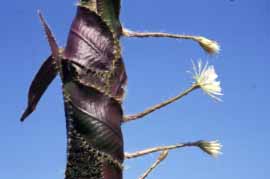
Strophocactus is a genus of cacti in the subfamily Cactoideae. Its status and circumscription remain somewhat uncertain, with the genus containing one to three species. Molecular phylogenetic data suggest that it consists of three species, including two formerly comprising the genus Pseudoacanthocereus. With this circumscription, the species have different growth habits, but share similarities in their flowers, which are white and open at night.

Hatiora is a small genus of epiphytic cacti which belongs to the tribe Rhipsalideae within the subfamily Cactoideae of the Cactaceae. Recent taxonomic studies have led to the three species formerly placed in subgenus Rhipsalidopsis being removed from the genus, including the well known and widely cultivated ornamental plants known as Easter cactus or Whitsun cactus.

Aylostera, is a genus of cactus, native to central Bolivia and north western Argentina.
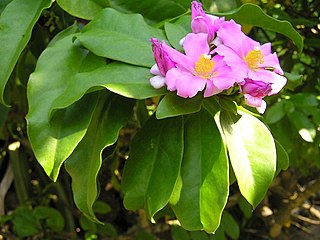
Rhodocactus is a genus of flowering plant in the cactus family Cactaceae, native to central South America. Unlike most species of cacti, Rhodocactus has persistent leaves and a fully tree-like habit. The genus was sunk into a broadly circumscribed Pereskia, but molecular phylogenetic studies from 2005 onwards showed that with this circumscription Pereskia was paraphyletic, and in 2016, Rhodocactus was restored for southern South American species.

Cacteae is a tribe of plants of the family Cactaceae found mainly in North America especially Mexico. As of August 2018, the internal classification of the family Cactaceae remained uncertain and subject to change. A classification incorporating many of the insights from the molecular studies was produced by Nyffeler and Eggli in 2010.

Selenicereus costaricensis, synonym Hylocereus costaricensis, known as the Costa Rican pitahaya or Costa Rica nightblooming cactus, is a cactus species native to Central America and north-eastern South America. The species is grown commercially for its fruit, called pitaya or pitahaya, but is also an impressive ornamental vine with huge flowers. The species may not be distinct from Selenicereus monacanthus.
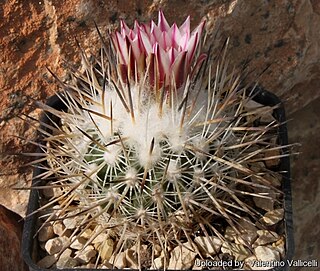
Rapicactus mandragora, synonym Turbinicarpus mandragora, is a species of plant in the family Cactaceae.
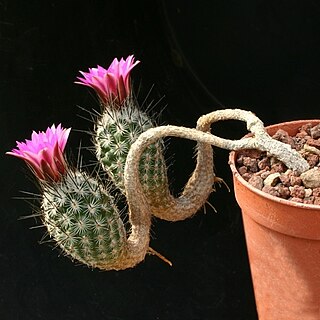
Rapicactus subterraneus, synonym Turbinicarpus subterraneus, is a species of plant in the family Cactaceae. It is endemic to Mexico. Its natural habitat is hot deserts.

The Rhipsalideae are a small tribe of cacti, comprising four or five genera. They grow on trees (epiphytes) or on rocks (lithophytes), where they either hang down or form creeping or upright shrubs. Their flowers open in the day and remain open at night; they may be either radially symmetrical (regular) or bilaterally symmetrical (zygomorphic). The fruits are berry-like, fleshy with smallish seeds.

The Hylocereeae are a tribe of cacti. Most are found in the tropical forests of Central and northern South America, and are climbers or epiphytes, unlike most cacti. The tribe includes between six and eight genera in different circumscriptions. The plants known as "epiphyllum hybrids" or "epiphyllums", widely grown for their flowers, are hybrids of species within this tribe, particularly Disocactus, Pseudorhipsalis and Selenicereus, less often Epiphyllum, in spite of the common name.

Epiphyllum hookeri is a species of climbing cactus in the Epiphyllum genus. It forms showy white flowers and is native from Mexico through Central America to Venezuela. A perennial, it was introduced to Florida and some West Indian islands.

Kimnachia is a monotypic genus of cacti. Its only species is Kimnachia ramulosa, synonym Pseudorhipsalis ramulosa, which is native from southern Mexico to northern South America and also found in Jamaica.
Deamia chontalensis is a species of flowering plant in the family Cactaceae, native to southwestern Mexico and Guatemala. It has sprawling or pendent branched stems and fragrant white flowers.

The Echinocereeae are a tribe of cacti in the subfamily Cactoideae. Since 2006, the tribe has included the former tribe Pachycereeae in many treatments of cactus classification. The exact circumscription of the tribe has been subject to considerable change, particularly since molecular phylogenetic approaches have been used in determining classifications, and remains uncertain. The tribe includes large treelike species, such as the saguaro, as well as shorter shrubby species. Most members of the tribe are found in desert regions, particularly in Mexico and the southwestern United States.

Rhodocactus sacharosa, synonym Pereskia sacharosa, is a species of flowering plant in the cactus family Cactaceae, native from Bolivia and west-central Brazil to Paraguay and northern Argentina. Like all species in the genus Rhodocactus and unlike most cacti, it has persistent leaves. It was first described in 1879.

Kadenicarpus is a genus of flowering plants belonging to the family Cactaceae. It is native to eastern Mexico. It has been synonymized with Turbinicarpus but molecular phylogenetic studies have supported its monophyly and separation from that genus.




